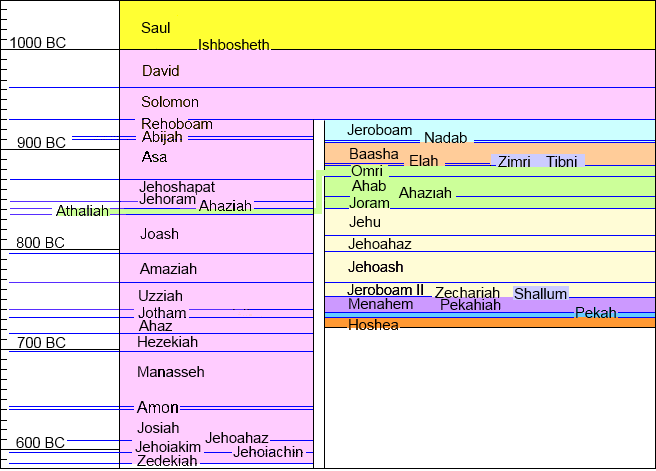REL 433 - Biblical Archaeology
Course Notes
Module 10 - Iron Age IIA
The United Monarchy, ca. 1,000-925 BC
![]() Chronology of the Kings of Israel and Judah
Chronology of the Kings of Israel and Judah
The absolute chronology of the kings of Israel and Judah is a matter of continuing discord among Bible scholars. The problem is that different cultures have used different methods of recording the length of a king's reign, and have used different calendars through the centuries, so it is no longer possible to assign absolute dates to events in the distant past.
The Israelites used a lunar calendar. When recording the length of a king's reign, they recorded the year in which he died as a full year. Some of the kings appointed one of their sons as a co-ruler towards the end of their life (eg. David and Solomon, I Kings 1:12-34) In the Northern Kingdom of Israel there was sometimes a period of civil war between reigns, with more than one person claiming to be King.
I usually use the chronology given by John Bright in his "A History of Israel". which may differs slightly from that used by our textbook.

The chart covers both Iron Age IIA (the United Monarchy), Iron Age IIB (the Divided Monarchy), and Iron Age IIC (Judah alone).
The kings of the Northern Kingdom of Israel are shown to the right, the kings of Judah, and of the United Monarchy, are to the left.
Different background colors indicate different dynasties.
![]() The United Monarchy, ca. 1,000-925 BC
The United Monarchy, ca. 1,000-925 BC
King Saul functioned more as a tribal chief and leader of a rather disorganized army, than as a central authority figure. The conditions of his reign are similar to the time of the Judges, the Early Iron Age, or Iron Age I. Israelite towns were generally small rural settlements; the Canaanites still had control of some of the larger inland cities such as Hazor and Megiddo, and the Philistines controlled the coastal plain. According to the Book of Judges, the Philistines also controlled the supply and repair of metal tools (I Sam. 13:19-22). Saul's headquarters were at Gibeah, and the main religious shrine for the Israelites was at Shiloh.
Note from the archaeologists : I Sam. 13:21, in the KJV says :
"They had a file for the mattocks, and for the coulters, and for the forks, and for the axes, and to sharpen the goads".
Modern translations usually say something along the lines of :
"The charge was two-thirds of a shekel for the plowshares and for the mattocks, and one-third of a shekel for sharpening the axes and for setting the goads." (NRSV).
That is because the Hebrew text uses the word "pim", and at the time the KJV was translated (1611) no-one knew what a pim was, so they made a guess that it was something to sharpen the implements. Recently, archaeologists found a set of stone weights, with their values incised on them - and one of them was marked as a "pim". The "pim" was about 8 grams, or a quarter of an ounce. I've been told that, if this was in silver, to charge a pim for sharpening a blade was rather exorbitant.
After Saul and Jonathan died in battle against the Philistines David moved his headquarters to Hebron as leader of the tribe of Judah, while Ishbosheth, a surviving son of Saul was set up as a puppet king by Abner, the general of Saul's army. However, after two years Abner was murdered, and then Ishbosheth was murdered, and the way was clear for David to become leader of all the tribes of Israel.
![]() Back to this week's Assignment
Back to this week's Assignment
Copyright © 1999 Shirley J. Rollinson, all Rights Reserved